By D.M. Robinson, P.E.
Introduction
My last article I discussed what I thought a minimum home inspection should include to allow an inspector to be able to provide a statement of the general condition of the equipment upon completion of the inspection. I thought I would cover the major components of a typical residential split system found in the Houston area. Also provided are some common things checked on an inspection when it is possible and accessible.
The major components of an air-conditioning system are:
- Thermostat
- Air Handler/Furnace
- Evaporator Coil
- Condensing Unit
- Ductwork
- Filters
Thermostat:
The thermostat should be securely mounted to the wall in a location that protects it from radiant energy and ensures it accurately reads the interior temperature for the zone it is controlling. The components of the thermostat should be secure and free from damage.
Air Handler/Furnace:
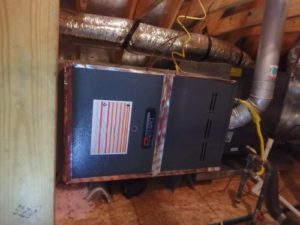
Horizontal Draft Gas Fired Furnace
The air handler, usually a heating furnace, either electrical or one fired with a combustible material for heat, must be securely connected and sealed to the inlet and outlet ducts so that it can operate efficiently. If the unit is an electrical device, the heating elements can often be checked for performance, either visually or with an amp meter. If they can be viewed, the elements should be observed to see that they are properly secured in the supports and are glowing when the heat is operating (this is often not possible). If the air handler is a natural gas fired unit, usually the case in the Houston area, the burner should be observed to verify that the flame is blue and steady and contained within the heat exchanger. The heat exchanger of most current equipment cannot accurately be checked for damage based upon a visual inspection. If the unit is some other type of combustion unit, such as oil fired, the burner performance should be viewed to see if it complies with the recognized performance for the kind of burner that it is.
Evaporator Coil:
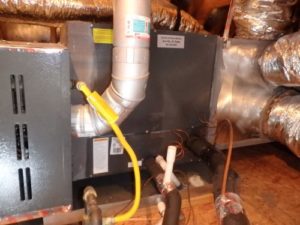
Evaporator Coil in Horizontal Air Handler.
An evaporator coil is located at the end of the air handling equipment or in some cases, such as with a typical electrically heated air handler, is integral to the air handler. Air is passed over the face of the coil by the air handler to cool the air and control humidity. The coil should be visibly inspected if an access point is provided to view its face for dirt, debris, damage, or deterioration. Taking temperature measurements at the inlet and outlet of the coil is typically recommended and is performing by many inspection contractors because it can provide information on how the coil is performing and insight into whether there is a need for further investigation in an inaccessible coil face. There should be no air leaks at the plenum interfaces to the coils and little or no air leakage at the refrigerant line penetrations. Condensate water is generated as part of the cooling process and the condensate collections systems should be viewed to determine the quality of installation to insure that condensate systems is adequately insulated and is draining to a sanitary sewer or away from the building. Where visible the catch pan systems should be viewed for evidences of leaks in the case of the coil which may indicate failure of the evaporator coil drains or a need for general maintenance.
Condensing Unit:
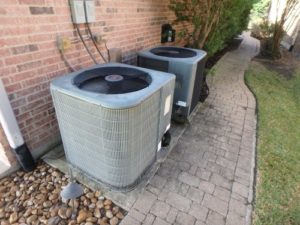
residential split system condensing units
The condensing unit is typically installed outside. The condensing unit must be observed from the exterior to verify that the coils are clean and in acceptable condition. The fan should be running smoothly and with no excessive humming, vibration, or rattling. The wiring to the condensing unit should be in conduit and in a good state of repair. Control wires, which are low voltage, should be secured to the refrigerant lines to prevent damage. The refrigerant piping to the unit should be in good condition with insulation intact and performing as intended on the refrigerant return line. The liquid line should be in good condition visually. If there is a liquid sight glass in the liquid line, it should have no bubbles when the system is operating. If the system has capillary tubes, there is no need for a sight glass and one would be of little or no use. The condensing unit access panel should be opened so that the electrical components can be viewed and the capacitors and relays can be viewed for evaluation. If there are leaking capacitors, they should be reported as in need of replacement. If the main contractor is burned, buzzing loudly or has other signs of deterioration, it should be reported as in need of repair. In general, the wiring in the electrical compartment of the condensing unit should be in good physical condition with no damaged or burned areas that could result in failure at any time. Condensing units can come in two common configurations including a standard type that is for cooling only and a heat pump system that can provide heating when configured with a compatible evaporator coil.
Ductwork:
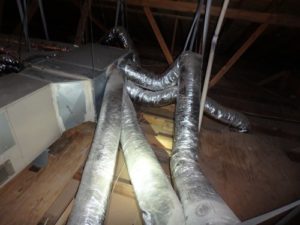
Flexible Duct
Ductwork should be in good repair. The insulation surrounding the duct and the vapor barrier covering over the insulation should be in good condition with no visible damage. Ductwork should be uniformly supported to prevent sagging that can damage hard pipe duct and cause a lower efficiency in flexible ductwork. Often, much of the duct in a home is not accessible or visible. Some systems use a single air condition system to serve several areas of the building that introduce additional components such as damper controls and computerized thermostat controls and balancing dampers that can be checked for general operation.
Filters:
Air-conditioning systems have filters that remove particles and dirt from the airstream to prevent clogging of the evaporator coil. Depending upon the type of filtration used, these typically require maintenance to replace or clean the filter every month to every 6 months. Filters should be clean and in good condition at all times.
There are many variations in the equipment discussed and in its methods of installation. The information presented is the most common description found in a typical home.
D.M. Robinson is a retired engineer and founder of Professional Engineering Inspections, Inc. Mr. Robinson has held a class A air conditioning license and master plumbers license. He is now retired and living the dream on a quiet lake enjoying the view.

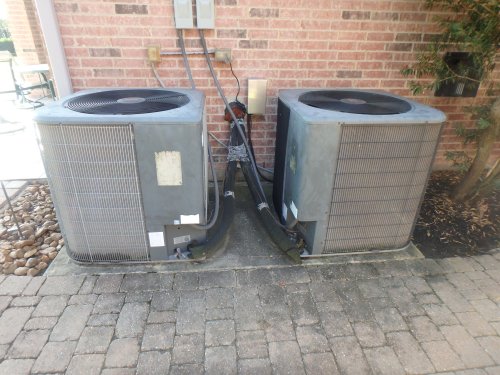
Recent Comments